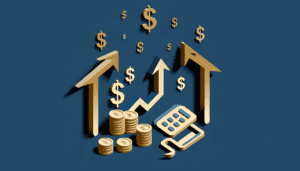The word every investor fears… RECESSION. Let’s take the sting out of the word and characterize the why and necessity of economic contraction.
Let’s start by talking about the definition and metrics of a recession. A recession is defined as two consecutive quarters of negative GDP Growth (which we had in Q1 and Q2). People argue and try to redefine the meaning of the word recession. Still, a simple definition wouldn’t do us justice in knowing the why and necessity of these periods of economic decline. There are many factors at play in looking at what metrics are used to warn of a recession. Here are a few recent developments I want to bring to the forefront.
- The FED goes HIKING
- As you have seen all over the news networks, Fed Chair Jerome Powell has again spooked the markets into a potential weekly loss of 2% or more for the major US indexes. What was a terminal rate of 4.75% is now being shattered like a baseball through a glass window. Chairman Powell now states that we could be flirting with a new terminal rate of 5.25% (a 50 bps increase and punch to the US economy’s gut). With the US Economy already slowing significantly, the FED could be, once again, the straw that breaks the camel’s (our economy’s) back. Rate hikes take months to bake into our economy, so a highly premeditated rate hiking campaign could overdo what was meant to primarily cool inflation and give us a “soft landing.” Meaning the potential for a worse-than-needed recession.
- Retail Sales
- This week’s retail sales numbers for November proved the economy is slowing quickly. With an estimate of -.3% reduction in retail sales for the previous month. The actual numbers came in twice as worse at -.6%. This sent the markets into “recession panic mode.” Emotion plays a big part in daily and short-term trading (a natural human emotion but one we must control when investing). Still, we must remember that we have been predicting and pricing a potential recession into the stock market for months now. The retail sales numbers for November are just a reminder that people are starting to spend less and planning for more challenging times ahead. No need to panic about what was already known (in my opinion).
- Employment
- In a traditional recession, the unemployment rate is usually higher than it is now (usually above 5%). At 3.7%, we are still in a tight labor market where we have too few workers able to fill too many job openings. If companies want to retain or attract talent, they must pay higher wages (thus the decent wage growth numbers we have been seeing). Unemployment numbers will become distorted due to the seasonal holiday jobs being filled. In 2023, I expect to see the unemployment rate continue to rise as companies lay off thousands of workers to steady the corporate cashflow ship.
While these are not the defacto or complete list of indicators we look at to determine a recession, I wanted to shed light on three relevant areas in today’s economic landscape and a staple on your favorite news networks. I expect the markets to test the October lows as the economy continues to slow down (remember, the stock market is a leading indicator and often recovers before the economy does in times of recession), but still favor equities over bonds due to the value you can often find in times of significant sell-offs. Dividend equities are our favorite equity style and for good reason… We value companies with large free cash flow reserves, healthy earnings, and iron-clad balance sheets. These companies often fare better in times of economic distress.
One quote I like in times of uncertainty is this: “The fear of suffering tends to be worse than the actual suffering.” Recession is a necessary part of the economic cycle to correct imbalances in the system and allow our economy to reset. Making sure rampant inflation does not consume us while furthering the potential for future economic growth, expansion, and free-market capitalism. It’s a beautiful struggle indeed! We are (most likely) nearer to the end of the rate hiking campaign than the beginning. Hang in there!
—
Important Disclosure:
The opinions voiced in this material are for general information only and are not intended to provide specific advice or recommendations for any individual.
All performance referenced is historical and is no guarantee of future results.
All indices are unmanaged and may not be invested into directly. There is no guarantee that a diversified portfolio will enhance overall returns or outperform a non-diversified portfolio. Diversification does not protect against market risk.
The economic forecasts set forth in this material may not develop as predicted and there can be no guarantee that the strategies promoted will be successful.







